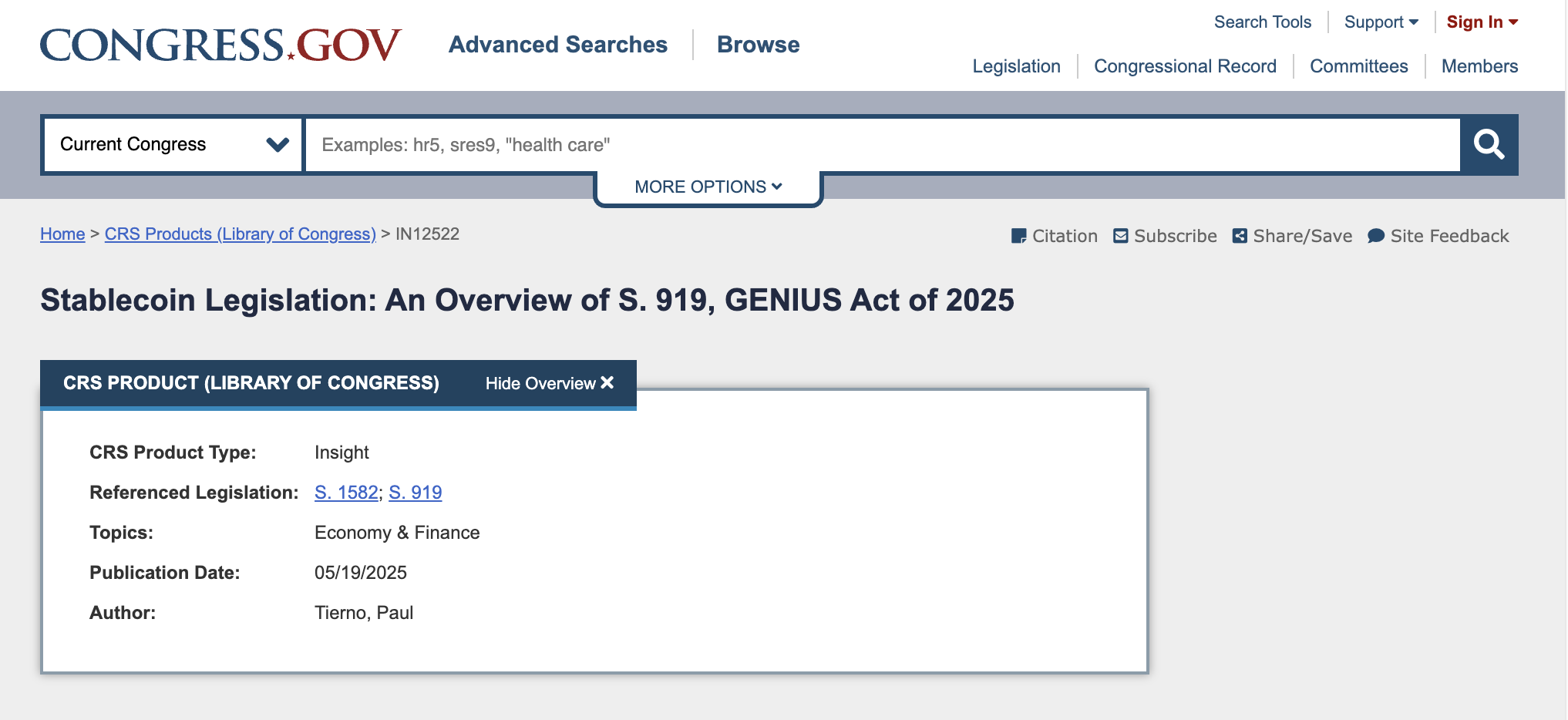Current Stablecoin Regulation Environment
The global regulatory landscape for stablecoins is rapidly evolving, with significant legislative efforts underway in key jurisdictions.
US Stablecoin Legislative Efforts
In the United States, stablecoin legislative efforts are well underway:
GENIUS Act: This pivotal stablecoin bill, which advanced in the Senate in May 2025, defines a payment stablecoin as a digital asset primarily intended for payment or settlement. It imposes restrictions on the issuer’s business, limiting it solely to the issuance, redemption, management, and safekeeping of stablecoins.
Crucially, the act mandates a one-to-one backing of all outstanding payment stablecoins with high-quality, liquid assets, explicitly specifying US Treasury Bills with a maturity of less than 93 days. The legislation also aims to limit the ability of stablecoins to offer yields, a measure potentially designed to prevent direct competition with traditional money market funds. Its focus is on establishing federal standards for federally permissioned issuers.


Source: congress.gov
STABLE Act: The House’s version of stablecoin legislation, the STABLE Act, clarifies that a payment stablecoin must be denominated in a national currency and explicitly excludes it from being defined as a “deposit” or “account” under existing banking laws. Similar to the GENIUS Act, it requires a one-to-one backing of stablecoins.
Under the STABLE Act, these federal standards would apply to all permitted payment stablecoin issuers, with federal authorities mandated to consult state authorities in developing these standards.
SEC Stance: In a significant development in February 2025, the US Securities and Exchange Commission (SEC) provided regulatory clarity for yield-bearing stablecoins by approving them as “certificates” subject to securities regulation.
This approval allows these assets to operate under specific rules, including registration, disclosure requirements, and investor protections, signaling a defined pathway for regulated yield-bearing products within the US.
Anti-CBDC Stance: US policy, particularly under the administration of President Trump, has adopted a strong stance against Central Bank Digital Currencies (CBDCs). These are viewed as inherently un-American due to concerns regarding privacy risks and potential government surveillance.
Instead, the US prioritizes privately-issued, dollar-backed stablecoins as the preferred mechanism for safeguarding and extending the global role of the US dollar.
International Stablecoin Regulation Approaches
Hong Kong‘s Legislative Council passed a comprehensive Stablecoins Bill on May 21, 2025. This positions the city as a regulatory leader. Its key provisions include stringent licensing, robust reserve asset mandates, and guaranteed par value redemption. Stablecoin holders also gain direct rights to reserve assets during issuer insolvency. Hong Kong’s approach may set a regional benchmark.
Meanwhile, Europe’s MiCA policies often favor Central Bank Digital Currencies (CBDCs). They typically view private stablecoins as potential financial stability risks. Italy’s finance minister, for instance, voiced concerns. He noted new US policies on dollar-backed stablecoins could threaten European financial stability.
Globally, over 80% of stablecoin transactions occur outside the United States. This fragmented regulatory landscape creates confusion and friction. It also leads to higher costs for consumers. The United States recognizes a “golden opportunity” here. It aims to establish international digital asset standards, potentially leveraging its G20 presidency.
Simultaneous legislation in the US (GENIUS Act, STABLE Act) and Hong Kong’s new law clearly demonstrate a global regulatory competition. The US links its stablecoin policy to maintaining dollar dominance. Hong Kong aims for regional benchmarks. Europe’s CBDC preference further underscores this competitive landscape. This divergence will likely fragment the global stablecoin market.
Different jurisdictions may favor distinct models, for example, the US favoring private dollar-backed stablecoins. Such fragmentation could impede seamless cross-border payments and interoperability. Consequently, businesses operating internationally will face significant operational and compliance challenges. The US’s proactive push for international standards is strategic. It seeks to mitigate fragmentation and shape the global landscape in its favor. This intertwines financial innovation with national economic and geopolitical interests.
For more: The Rise of Stablecoins: 2025 Market Update and Key Statistics
Future Stablecoin Regulation Trends
Looking ahead, stablecoin regulation will intensify. Regulators will focus on stability, transparency, and responsible growth.
Transparency will be key. Issuers must fully disclose reserve parameters. Regular, independent audits will become mandatory. Standardized reporting will ensure consistent reserve data. This will foster public trust and accountability.
For stabilization, regulators will demand clearer definitions. Issuers must define peg thresholds. They will outline scenarios where the peg might compromise. Robust contingency plans will protect users. Regulators will distinguish “relative stability” from “absolute stability.” Issuers need comprehensive risk management, including capital buffers and liquidity reserves. These will sustain stablecoin value during volatility.
Regarding scalability, regulatory bodies will assess suitable industries. High-risk sectors like gambling may face stricter limits due to AML concerns. Conversely, remittances and cross-border payments will likely receive more support. These areas offer significant potential for financial inclusion and efficiency.
Finally, international collaboration is essential. Stablecoin transactions are global. Cohesive global frameworks are needed. Collaboration aims to reduce fragmentation and foster interoperability. It will ensure consistent standards across jurisdictions.
Future Stablecoin Regulation Outlook and Recommendations
The stablecoin market is poised for substantial growth and increasing integration into the broader financial system.
- Projected Market Growth: The stablecoin market expects significant growth. Projections indicate it could reach $2 trillion by 2028. This is a substantial increase from its current $234 billion valuation. Stablecoin issuance might double to $500 billion within the next 18 to 24 months. Within this expansion, yield-bearing stablecoins are set to gain market share. They could capture 15% of the total market, representing $75 billion in issuance. This signifies a sevenfold growth from current levels.


Source: Coingecko
- Increasing Integration with Traditional Finance: Stablecoins are expected to play an increasingly crucial role in shaping the international financial system. They are viewed as a vital bridge linking traditional financial institutions with emergent financial technologies like blockchain and DeFi protocols. Banks and financial institutions have already begun to integrate stablecoins into their offerings, signaling a growing acceptance and movement towards mainstream adoption.
- Strategic Recommendations for Businesses and Investors: To effectively navigate this dynamic sector, businesses must maintain agility, integrate sophisticated compliance controls, and actively participate in ongoing regulatory discussions. For investors, regulatory clarity is identified as a paramount driver for market growth and should be closely monitored when making allocation decisions. The industry’s long-term success will depend on its ability to adapt to new compliance requirements while simultaneously continuing to innovate in critical areas such as cross-border payments and digital finance applications.
Stablecoins’ future in mainstream finance hinges on robust regulation. Clear, internationally coordinated frameworks are fundamental. Without these, compliance, security, and systemic risk concerns will limit institutional and public acceptance.
The “wild west” era of stablecoins is ending. A more structured, supervised environment is emerging. Regulatory responses worldwide will increasingly dictate stablecoin innovation and adoption pace. Regulatory clarity acts as the primary catalyst for mainstream institutional adoption.
 Bitcoin
Bitcoin  Ethereum
Ethereum  Tether
Tether  XRP
XRP  USDC
USDC  TRON
TRON  Lido Staked Ether
Lido Staked Ether  Dogecoin
Dogecoin  Figure Heloc
Figure Heloc  Cardano
Cardano  WhiteBIT Coin
WhiteBIT Coin  Bitcoin Cash
Bitcoin Cash  Wrapped stETH
Wrapped stETH  Wrapped Bitcoin
Wrapped Bitcoin  USDS
USDS  Wrapped eETH
Wrapped eETH  Binance Bridged USDT (BNB Smart Chain)
Binance Bridged USDT (BNB Smart Chain)  Chainlink
Chainlink  Monero
Monero  LEO Token
LEO Token  WETH
WETH  Zcash
Zcash  Stellar
Stellar  Hyperliquid
Hyperliquid  Coinbase Wrapped BTC
Coinbase Wrapped BTC  Ethena USDe
Ethena USDe  Litecoin
Litecoin  Sui
Sui  Avalanche
Avalanche  Hedera
Hedera  sUSDS
sUSDS  Shiba Inu
Shiba Inu  USDT0
USDT0  Dai
Dai  Canton
Canton  Uniswap
Uniswap  PayPal USD
PayPal USD  Mantle
Mantle  Cronos
Cronos  Toncoin
Toncoin  World Liberty Financial
World Liberty Financial  Ethena Staked USDe
Ethena Staked USDe  Polkadot
Polkadot  USD1
USD1  Aave
Aave  Rain
Rain  Bitget Token
Bitget Token  MemeCore
MemeCore 


